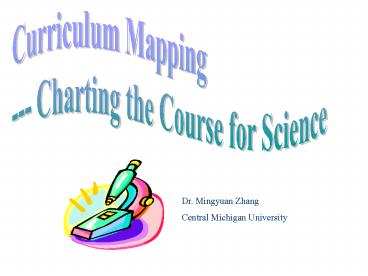Curriculum Mapping - PowerPoint PPT Presentation
1 / 22
Title: Curriculum Mapping
1
Curriculum Mapping --- Charting the Course for
Science
Dr. Mingyuan Zhang Central Michigan University
2
Welcome and Introduction
3
Agenda
- Curriculum Mapping
- What, Why, and How
- Mapping at a Class Level
- Mapping at a Grade Level
- Mapping at a School Level
- Wrap-up
4
K-W-L
- What do you know about curriculum mapping?
- What do you want to know about curriculum
mapping? - What have you learned about curriculum mapping?
5
What Is Curriculum Mapping?
- Curriculum mapping is a procedure for collecting
data about the actual curriculum in as school
district using the school calendar as an
organizer.
6
We Need Two Lenses
Why Do Curriculum Mapping?
- A zoom lens into this years curriculum for a
particular grade.
7
We Need Two Lenses
- A wide angle lens to see K-6 perspective.
8
Why Do Curriculum Mapping?
- Do you know what your colleagues of the same
grade are teaching? - Is it possible that some important skills you
assume someone will teach has never been taught? - Is the content you are teaching repeated by other
teachers?
Curriculum mapping can be the answers to the
questions.
9
Why Do Curriculum Mapping?
- Gain information
- Identify gaps
- Identify repetitions
- Identify potential areas for integration
- Match assessment with desired outcomes
- Review for timeliness
10
Learn and Critique
- What information is included on the maps?
- What is possible with the information on the
maps? - What would you be able to do if you had this
information?
Form small groups, choose a facilitator and a
recorder.
11
Phases of Curriculum Mapping
How?
- Collecting the Data
- The First Read-through
- Mixed-group Review
- Large Group Review
- Determine Points That Can Be Revised Immediately
- Determine Points That Require Long-term Research
- Review Cycle Continues
12
Phase I Collecting the Data
- Each teacher records three major elements on a
calendar-based curriculum map content, processes
and skills, and assessments.
13
Phase II The First Read-through
- Teachers will do the following
- Read each others maps to gain information
- Look for gaps,
- Look for repetitions,
- Identify potential areas for integration,
- Match assessment with standards,
- Review for timeliness.
14
Phase III Mixed-group Review
- A small group of people from different grade
levels shares and lists findings from the first
read-through.
15
Phase IV Large Group Review
- All faculty members meet to share findings.
16
Phase V Determine Points That Can Be Revised
Immediately
- Faculty members address changes that can be made
without further study.
17
Phase VI Determine Points That Require Long-term
Research
- A task force is formed to do research and make
recommendations.
18
Phase VII Review Cycle Continues
- Review and revision continue
- to keep maps timely.
19
Video Viewing Activities
- What is curriculum mapping?
- What is included in curriculum mapping?
- How does mapping improve student performance?
20
K-W-L Revisited
- What have you learned about curriculum mapping?
21
Curriculum Mapping Charting the Course for
Science
- Each teacher records major elements on a
calendar-based science curriculum map content
and process skills. - Teachers from the same grade read each others
maps to complete a grade level map for science. - Representatives from different grade levels chart
the course for science for their respective
schools.
22
Elements on a Map
- Content Unit, concept, theme
- Process skills Specific, assessable, and
expressed with verbs - Assessment demonstrations of learning, tangible
products or observable performances, and
expressed with nouns































